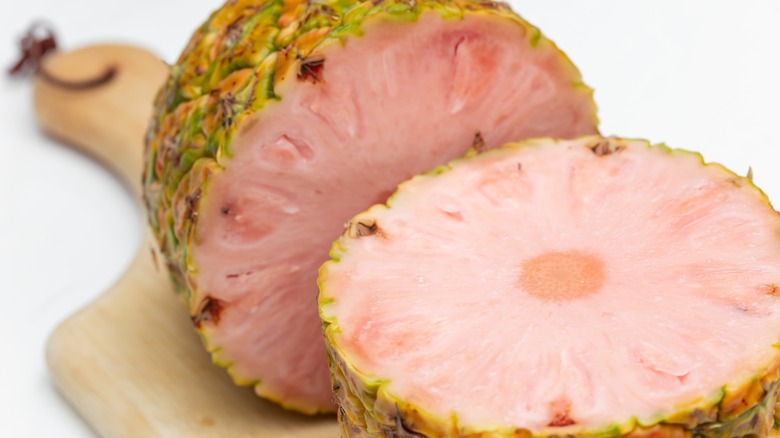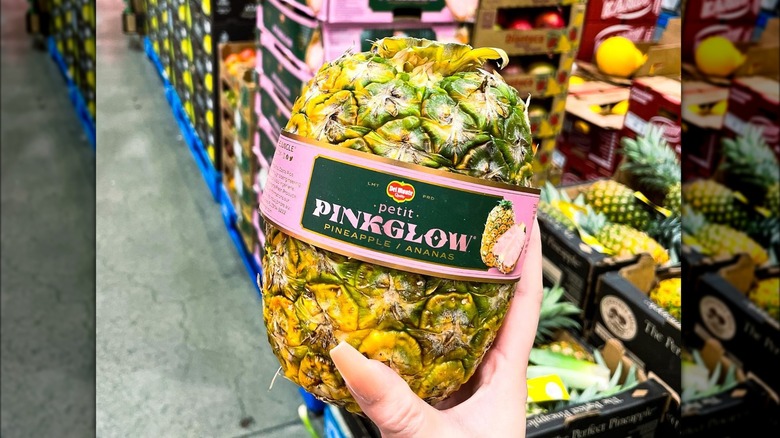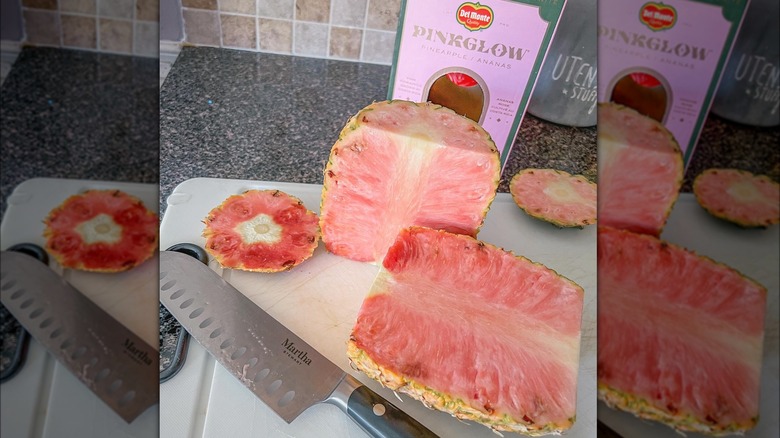Why Are Some Pineapples Pink?
You may have seen them at the supermarket, or (more likely) on Instagram; either way, we now live in a world with pink pineapples. This isn't a variety humanity just happened upon, but is part of a rapidly growing ecosystem of "designer fruit" that includes the likes of cotton candy grapes and seedless watermelons (which aren't technically seedless).
Called Pinkglow — a name trademarked by Fresh Del Monte, since the fruit is grown and supplied exclusively by the company — these rosy pineapples are sweeter, juicier, and less tart than the yellow-fleshed breeds. The label affixed to each fruit notes each is "made possible through bioengineering," as Del Monte has put decades into developing them, crossbreeding individual plants with attributes that appeal to popular tastes (literally and figuratively). Pinkglows are a genetically engineered version of its previously iconic Gold Extra Sweet variety of pineapples, which themselves took about 30 years to develop.
While early GMO pineapple varieties were more focused on maximizing flavor and nutrients (in addition to improving growing viability), the sheer novelty of them makes Pinkglows incredibly "Instagrammable." Though that doesn't change the fact that they're delicious and inject extra festivity into anything they're added to, whether it's a fruit salad or a cocktail. The real challenge, one could say, is eating a Pinkglow pineapple without taking a picture of it.
Pink pineapples contain the same pigment as tomatoes and watermelons
While Fresh Del Monte didn't set out to create pink pineapples, it was discovered the fruit naturally contained lycopene — an organic pigment responsible for giving tomatoes and watermelons their distinct red color. In other pineapples, lycopene is converted to the yellow pigment beta-carotene, but by modifying the pineapple's genome to produce more lycopene and suppress the its lycopene-converting enzymes, more of the red pigment is retained in the flesh.
Development of the rosy-hued fruit started around 2005 according to the patent filed by the company (yes, Pinkglow pineapples are patented), and it took several years to perfect the commercially viable pink pineapples we see today. All Pinkglow pineapples are grown in Costa Rica, which is one of the world's largest pineapple producers. When you purchase a Pinkglow pineapple, you'll notice that it doesn't have a crown (the bunch of spiky leaves on top). This is because the crowns are cut off during harvesting and used to grow the next batch; while this is attributed to sustainability, it also ensures that you won't be able to grow your own at home.
Tips for storing and enjoying Pinkglow pineapples
Unless it's part of a table full of exotic foods, a pink pineapple should generally be the star of the show. Whole rings or chunks of pink pineapple make for a dramatic presentation, so use that Pinkglow for garnishing salads and cocktails. It can also elevate cheese charcuterie boards and make them look more exotic. Because of its sweeter flavor profile, dehydrated pieces of pink pineapples are delicious and also retain the pink hue. Perhaps the only time you'll have to think twice about using a Pinkglow is when a dish requires pineapple's tart and acidic notes. Therefore, a sweet-and-sour stir fry is probably not the best place to use it (though not out of bounds, either).
Pinkglow pineapples will last for up to seven days in the fridge and three months in the freezer when stored in airtight containers. This is a good thing because you don't want a Pinkglow spoiling given that it costs about double the price of a regular pineapple. Supermarkets sell Pinkglows for around $10, but buying them online can cost about $30 or more. Whether the price is justified is debatable, but considering pineapples cost the equivalent of thousands of dollars in the past, it's interesting to see this fruit, relegated to cans for so long, become a luxury item again. In fact, Fresh Del Monte's $400 Rubyglow pineapple, which has a red exterior (but, disappointingly, a regular yellow interior) makes the Pinkglow look like a bargain.


